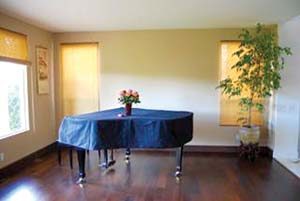People often ask me to appraise their piano. Since with great pleasure I do this for the Music Academy of the West, I’ll discuss the value of a reader’s piano. People ask if upright pianos are worth anything. A good upright is worth more than a lower-range grand piano. Both are equally difficult to sell on the second-hand marked ($500-2,000).
Good brands to purchase at resale:
 Yamaha and Kawai grands
Yamaha and Kawai grands- Charles Walter and Sons
- Young Chang
- Sammicke and Sohnner.
A used Steinway or Mason and Hamlin eventually needs restoring (partial restoration) or refurbishing (full restoration), that will run into the four-figures at least.
Upright piano brands that hold both quality and investment, according to the National Piano Institute website:
- Acrosonic (the piano I learned on)
- Baldwin
- Charles R. Walter
- Falcone
- Hamilton
- Kawai
- Mason and Hamlin
- Sohmer
- Yamaha
- Steinway
- Seiler
- Schimmel
- Schiedmeyeral Schafer & Sons
Pianos of originally lower cost are made of lower cost materials and you’ll spend more to keep these pianos in tune. A piano’s strings need pulling to a tension of 170 pounds per string. Each piano consists of 220 strings, which means your piano, when tuned properly, contains 40,000 pounds of tension. The posts and the cast iron plate must support this, thus if the materials are of lesser quality, you’ll need a fulltime piano tuner.
No matter how young your budding pianist, I don’t recommend an electronic keyboard, a market once filled by the spinet and console upright piano. No substitute exists for learning how a subtle touch to a key influences the “feeling” of a note. If you consider buying a new piano, think about the secondhand market for spinets and consoles, and ask a piano technician to check it out. Sometimes the older pianos are made better and finished over time, which today’s labor force can’t afford. “The action regulation” of a piano, to register human touch, is engineered to a tolerance of a few thousands of an inch.
Three components of service which a registered piano tech can do:
- Voicing, service to the felt part of the hammers
- Action regulation, the engineering of “touch”
- Pitch, turning the pegs which hold the strings to achieve the correct pitch
A piano requires service at least twice a year.
A great hint for cleaning your keys
Use three-parts water to one-part white vinegar on cheesecloth, and wipe the keys towards you to avoid getting moisture in between the cracks. For either ivory or composite keys, use a little toothpaste lightly wiped off with a milk-soaked, wrung-out cheesecloth rag. Or try denatured alcohol, but use separate rages for the white and black keys.
Finally, pay attention to where the piano lives. Don’t place the piano over or near vents or in sunlight. Let a technician vacuum the piano’s interior. Don’t use furniture polish, that will gum-up on top of the finish. And don’t fear the ghost in your piano. The piano holds within it 20 tons of tension so the piano will pop and squeak occasionally. Don’t oil that squeak!
Pingback: What to do with a piano - Elizabeth Appraisals